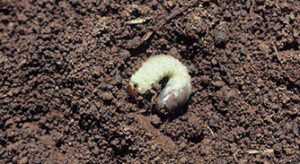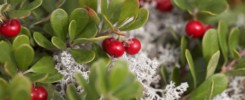
by David Cappaert, Bugwood.org
You’ve seen lawns around the region destroyed by animals and birds searching for a juicy chafer beetle snack. Now there’s a new beetle in town. And it’s even worse! The Japanese beetle (Popillia Japonica) is threatening lawns, gardens, and landscaped areas in a few Metro Vancouver municipalities. In response, steps are being taken by local and federal authorities to curb the spread of this invasive species. But anyone who cares for a garden or lawn can also play a role. Here’s some of the things to look out for, and some steps you can take.
What is the Popillia Japonica?

by Jim Baker, North Carolina State University, Bugwood.org
Popillia japonica is a small bug approximately 15 mm long and 10mm wide, with iridescent copper and green colouring. The larvae feed on the roots of grass and just like the chafer beetle, crows, skunks, and raccoons will tear up lawns to eat the beetle larvae.
What does it do?

by M.G. Klein, USDA Agricultural Research Service, Bugwood.org
Damage. And lots of it. More destructive than the chafer beetle, Popillia japonica doesn’t just attack lawns. Over 250 species of plants are food for the adult beetle, whose voracious appetite includes roses, perennials, fruit trees, and countless other landscape and food plants.
When did the problem start?

by Bruce Watt, University of Maine, Bugwood.org
The beetles were first spotted in a trap in the False Creek area in August 2017 – the first time it has been found in BC. However, it has been in North America since the early part of the 20th century, probably arriving with shipments of iris bulbs from Japan, before commodity inspections were a standard protocol in the US. It began showing up in Northeastern Oregon residential and agricultural lands circa 2016. Over 900 beetles were trapped in the False Creek area in 2017, and over 9,000 in 2018. Since then, fewer and fewer beetles have been detected in Vancouver; however, Popillia japonica has now been found in municipalities outside Vancouver.
How are authorities addressing its spread?
A coordinated approach to eradicate Popillia japonica is underway. The federal government has ordered that ‘plants with soil or soil-related matter attached’ can’t be moved out of regulated areas in the map to the right, year round. Anyone wishing to move these materials outside these areas must contact the Canadian Food Inspection Agency at 604-292 5742 or BCPF.Japanese.Beetle@inspection.gc.ca for more information.
The cities of Vancouver, Burnaby, Port Coquitlam, Coquitlam, the federal and provincial governments, the Invasive Species Council of British Columbia, the landscape and nursery industry, and Metro Vancouver are working together to stop the Japanese beetle. Cities are applying a larvicide called Acelepryn to boulevards, medians, and lawns on public property. The larvicide is not harmful to humans, pets, other animals, or pollinators like bees and butterflies. Private property owners in priority treatment areas will receive additional information in the mail.
You can learn more about local treatment efforts on these websites:
Treat public property for Japanese beetle | City of Vancouver
Japanese Beetle | City of Burnaby
Japanese Beetle Treatment | City of Port Coquitlam
Popillia japonica (Japanese Beetle) Pest Alert | Province of British Columbia
How can you help?

If you live in the regulated area, the most important thing you can do is abide by its restrictions. That means until further notice, the movement of ‘plants with soil and soil-related matter’ out of the regulated area is prohibited year round to avoid spreading the larvae. Examples of ‘plants with soil and soil-related matter’ include plants for planting, turf grass, sod, ornamental grasses, annuals, perennials, bulbs, shrubs, bedding plants, and patio plants.
If you see what looks like Popillia japonica anywhere in our region, please contact the Canadian Food Inspection Agency at 604-292 5742 or BCPF.Japanese.Beetle@inspection.gc.ca
Please don’t disturb or remove any beetle traps you may see in your neighbourhood. They’re playing a critical role by helping to track beetle numbers.
Immediate Action Protects Local Agriculture and Ecology

Invasive species can do real damage to local crops and ecosystems. Beyond the ugly plant damage and inconvenience for gardeners, invasive species like the Popillia japonica could cost local farmers millions of dollars and threaten local food security. Left unchecked, the beetles could also spread further into parks and other natural spaces, ultimately impacting the ability of those areas to provide the clean water, fresh air, and recreational opportunities upon which we depend. However, with continued cooperation between governments and support from the public, the
Additional Resources
Canadian Food Inspection Agency – Japanese Beetle Fact Sheet
Province of British Columbia – Popillia japonica (Japanese Beetle) Pest Alert
City of Vancouver – Japanese Beetle information page
City of Burnaby – Japanese Beetle | City of Burnaby
City of Port Coquitlam – Japanese Beetle Treatment
BC Landscape and Nursery Association – Japanese Beetle
Metro Vancouver – Japanese Beetle (Popillia japonica) page
Invasive Species Council of British Columbia – Japanese Beetle


